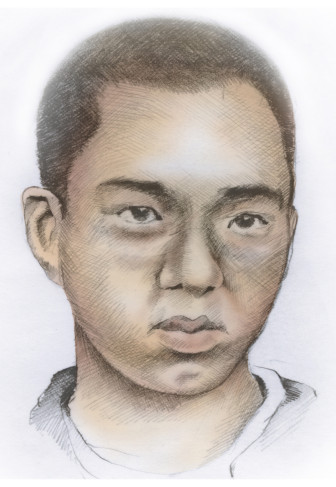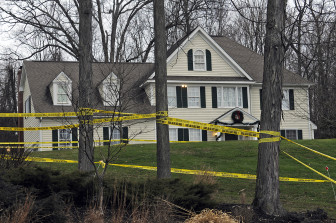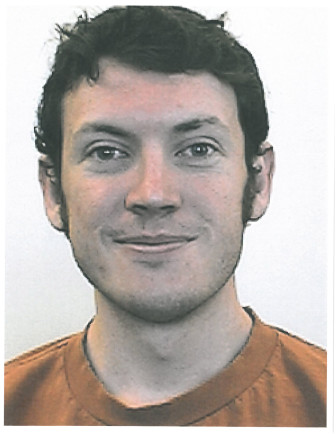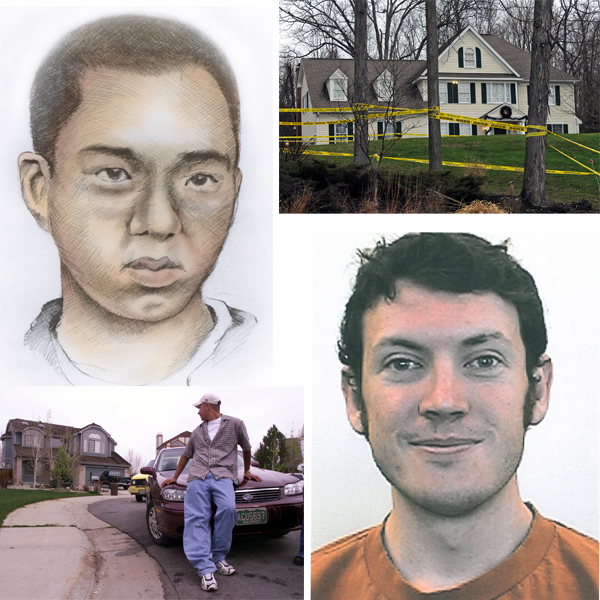
Lee Hulteng / MCT
Illustration of Virginia Tech gunman Seung-Hui Cho, who killed 32 students and himself in April 2007.
College senior Seung-Hui Cho awakened early on the morning of April 16, 2007. According to his suitemates, he had been up since at least 5 a.m., typing away at his computer.
About 30 minutes later, Cho, still in his boxers, went inside a Harper Hall bathroom on the campus of Virginia Tech. He brushed his teeth, and scrubbed his face with acne wash. The night before, he had made his weekly phone call to his family, who were living in nearby Fairfax County. Another uneventful, if not boring, conversation, his family later recalled.
Cho returned to his bedroom, got dressed, and left the suite. At about 6:45 that morning, a student hanging out in the foyer of the West Ambler Johnston resident hall saw Cho wedged between the interior of the building and a mailbox foyer. About 15 minutes later, Emily Hilshcer entered the dorm after being dropped off by her boyfriend.
Gunshots rang out in Hilshcer’s bedroom at 7:15. Moments later, Cho walked out of the resident hall. He left behind several spent shell casings, a smattering of bloody footprints and his first two victims, Hilshcer and Ryan Christopher Clark, a residential assistant who lived next door.
Just two minutes after the murders, Cho walked back over to his residence hall, swiped his student ID and returned to his suite, where he changed out of his bloody clothing. While first responders were uncovering the bodies at West Ambler Johnston, Cho logged onto his student e-mail one more time. He erased all of his files and deleted the account.
For the next hour, police canvassed West Ambler Johnston, desperately seeking witnesses, while policy officials at Virginia Tech met to determine the best way to inform the community about the shootings.
About a half-hour later, Cho entered Norris Hall, a building that primarily housed engineering classes. From the inside, he chained shut three of the building’s public entrances. At 9:26 a.m., Virginia Tech officials sent out mass e-mails to staff, faculty and students, informing them of the double-homicide that had occurred earlier that morning. Twenty minutes later, Cho entered room 206 where an Advanced Hydrology class was underway, and opened fire.
Eleven minutes and a 174 rounds of ammunition later 31 people, including Cho, were dead, with an additional 17 sustaining serious injuries.
The next day, Cho is declared the man responsible for the deadliest, single-shooter massacre in United States history.
On CNN, Fox News and MSNBC, anchormen and pundits debated the merits of gun control and psychiatric medication, trying desperately to deduce why the 23 year-old college student embarked upon such an orgy of death and destruction.
Commonalities Among Young Killers
Dr. Michael Kimmel, professor of sociology at the Stony Brook University, has written more than a dozen books on constructs of “masculinity” in culture. When evaluating recent school shootings, he notices several commonalities that, while seemingly superficial, may provide vital clues as to why young men engage in such acts of bloodshed.
“They are virtually all white, they are virtually all using assault weapons and rifles -- not handguns -- [and] they all say or claim to be the victims of relentless bullying and gay-bashing,” he said.
Regarding Cho, Kimmel said that while his race made him an outlier among school shooters, he shared almost all of the common traits that other young mass killers foster.
Without first addressing how these individuals perceive their own identities, Kimmel said finding ways to prevent school massacres are impossible.
“You cannot explain it without talking about masculinity,” Kimmel said. “You cannot explain it without talking about the fact that of all [recent] school shootings, all 30 of them or so, 29 have been committed by boys.”
“The questions we want to ask at the end of this,“ he said, “is what are the characteristics of these boys, and what are the characteristics of the schools where they explode?”
Dr. Michael Welner, chairman of The Forensic Panel, examined an attempted mass killer for the first time in 1996. Since then, he’s evaluated six more individuals that either embarked upon mass killings or attempted massacres. Not only has he interviewed, in-depth, people like Cho, he said he has reviewed their lives in “minute detail” as part of criminal proceedings against them.
Like Kimmel, he sees a link between young killers and what he deems “violent constructs of manhood.”
“The psychological factors of mass killing universally involve someone who equates destructiveness for destructiveness’ sake with an expression of masculinity,” he said. “It is an impersonal crime that is all about the killer’s expression, directed at people to whom he is largely detached.”
As a forensic psychiatrist, Welner has spent the last two decades examining mass murderers and seeking ways to prevent tragedies like the Virginia Tech massacre from transpiring.
“I have lived this topic in many ways and for many years,” he said. “And I absolutely believe it can be eliminated.”
Going Out in a Blaze of Glory

Stephen Dunn / Hartford Courant/MCT
Police tape surrounds the area near the home of Nancy Lanza, the mother of Adam Lanza, who fatally shot twenty children and six adult staff members in a mass murder at Sandy Hook Elementary School in December 2012.
What separates mass killers from spree killers, Welner said, is the shooter’s primary intent. Spree killers -- like Christopher Dorner, the former LAPD officer suspected in four murders earlier this year in California and Andrew Cunanan, who killed five people, including fashion designer Gianni Versace, in a multi-state spree in 1997 -- are individuals that, in the aftermath of an initial crime, begin killing others during flight from capture. Mass killers -- like Adam Lanza, Eric Harris, Dylan Klebold and countless others over the years -- instead select a particular site with the intent of targeting a large number of victims.
Killings of the like, he said, are most likely perpetrated because the killers aim for “transcendent notoriety.” The greater numbers killed, the greater the media coverage, Welner said. Shooters like Cho, he believes, are certainly aware of the fact.
“With the advent of 24-hour news, pressured competition among new networks and the ability to engage breaking news from many directions, a number of more recent mass killings have drawn unprecedented coverage,” Welner said. “Thus it is not merely the news coverage afforded catastrophe, but how humanizing coverage erodes the borders between right and wrong.”
Kimmel said that school shootings have “evolved” through three stages over the last 30 years. Up until the early 1990s, he said that most on-campus homicides were perpetrated by young men of color, generally with handguns, against specific targets, in “individual acts of vengeance.” With the proliferation of metal detectors and armed personnel in urban schools, he said that school shootings of the like have all but disappeared. “It’s not that the violence has actually decreased,” he said. “Now, they wait off school grounds and shoot them.”
He calls the 1992-1999 timeframe “the classic phase of random rampage school shootings.” During this period, most school shootings were enacted by young white males, generally living in suburban communities, who seemed to kill random students and teachers using assault rifles. He cites shootings in Jonesboro, Ark., and Paducah, Ky., as the archetypical “classic” school shooting of the time period. The perpetrators, he said, were miserable young men that felt extremely aggrieved, and almost all of them were arrested after their violent outbursts. “Some sat down and waited to be arrested by the police,” Kimmel said. “They are all in jail now.”
After the Columbine High School massacre in 1999, however, Kimmel said that most school shootings since have been instances of “suicide-by-mass murder,” with triggermen intending to die -- usually, at their own hands -- at the end of their shootings.

Michael Mulvey / Dallas Morning News/MCT
A Columbine High School student looks over his shoulder at the home of Eric Harris, one of two student gunmen involved in the massacre at Columbine High School. Littleton, Colorado.
“These guys want to kill themselves,” he said. “That’s their primary motive, but what they also want to do is take as many of their tormentors with them when they go.”
As with Welner, he believes that some young mass killers may embark upon such rampages due to a thirst for notoriety.
“One of the characteristics that all of the recent school shooters do have is a desire for fame and glory, that when they go, they’re going to go out in a blaze of glory,” he said. “And everybody will remember them forever.”
Vengeful, Righteous Violence
“Children are not born to hate,” Welner said. “Culture matters.”
In analyzing American culture, both Welner and Kimmel detect a certain sense of “destructiveness” in modern constructions of masculine identity.
“What virtually every man knows is that violence ought to be a last resort,” Kimmel said. “But it is always an available way to resolve differences -- I draw a line in the sand, and dare you to cross it.”
Regarding young mass killers, Kimmel said that the problem isn’t usually gender non-conformity, but rather, an “over-conformity” to masculine ideals. The young men, he stated, may have felt victimized, and believed that their victimization was unseen or uncared about by others.
“Somebody’s bullying you, and your daddy says, ‘eventually, you’re just going to have to stand up to them,’” he said. “That’s what we learn, and that’s what these guys did.”
Welner believes that mass killings are often “endpoints” of pathways that begin much earlier in the lives of young shooters. “In its earliest stages, the mass killer blames others for shortcomings and socially has difficulty fitting in,” he said. “As he grows into adolescence, he has great sexual insecurity and identifies with the expression of masculinity through destructiveness, particularly with weapons.”
Young people embarking on murderous rampages, he said, generally grow more alienated as get older. Many times, he said, they develop a general resentment for everyone around them; they may begin identifying with mass killers, with the young men eventually developing elaborate homicide fantasies. He said that frequently, these individuals become invested in certain grievances, which they may feel a need to “protect” by hiding themselves away from others.
“At the point when the killer believes his once-higher hopes for himself will never happen, he chooses to embark on a mass killing, to pass from anonymity and marginality to a story that is relevant to all,” Welner said.
A certain sense of “masculine destruction” is imbedded in American culture, Kimmel said. Though he doesn’t believe it’s the sole factor in mass shootings, he similarly believes that it is impossible to analyze incidents without addressing the subject.
“Some of them learn it from their father, some of them learn it from other boys, some of them learn it from media images,” he said, “but basically, this idea that vengeful, righteous violence is legitimate is ingrained in virtually all boys.”
There’s No One There To See It
Kimmel believes that mass killings perpetrated by young men are a multifaceted issue, and no lone culprit -- be it guns, mental illness, or masculine destructivity -- can fully explain why events like the Virginia Tech massacre occur.
However, when exploring school shootings, he believes that the environments themselves are frequently overlooked as possible “motivations” for mass killings.
“In addition to profiling the shooters themselves, I think we also need to profile the schools that they come from,“ he said. “They’re not just randomly distributed in our country.”

University of Colorado Denver / Zuma Press/MCT
James Holmes, the suspected perpetrator of the mass shooting in July 2012 at a Century movie theater in Aurora, Colorado, which killed 12 people and injured 58 others.
Some schools, he said, are simply more likely than others to be the sites of mass killings. Most recent school shootings, he said, have occurred at places where the student body is “overwhelmingly white” -- sometimes constituting as high as 98 or 99 percent of the complete population. They also tend to be “jockocracies,” he adds -- environments where student athletes “rule with absolute impunity,” whose bullying of other students is often overlooked by administrators and teachers.
“If you are targeted or bullied and gay-bashed in those kinds of schools, you have nowhere to turn, because there’s only one culture, and you’re either in it or out of it,” he said.
He believes that was the case with Cho. Campuses of the like -- where students have such a deep identification with the school as a “brand -- generally represent a “monoculture” where students are either insiders or outsiders. He says that the atmosphere at Columbine High School was similar.
Kimmel believes that youth who feel alienated and victimized could benefit greatly from counseling services. But in the wake of No Child Left Behind, which he refers to as “the worst educational policy ever enacted,” many schools have cut back on non-curricular costs.
“These kids who explode, they don’t ever get seen by a guidance counselor,” he said. “They don’t ever get seen by therapists in high school, they just fly under the radar.”
When mass killings on school grounds occur, Kimmel said that a frequent reaction from bystanders is “oh my, no one ever saw it coming.”
“Well, that’s right,” he responds. “There’s no one there to see it.”
Counseling interventions, he believes, could serve as a vital deterrent to prevent future school massacres.
“We have got to make a choice and a commitment at the national level, state level and local level to put more counselors in schools,” he said. “Not more armed guards, not metal detectors, but people who actually talk to these kids.”
Finding Solutions
Neither Welner or Kimmel believe that there’s a “quick fix” remedy to the problem of mass violence perpetrated by young people. However, they do believe that, by addressing larger social and cultural issues, there may be an avenue to reduce the number of mass shootings that transpire in the United States.
According to Kimmel, a pivotal first step would entail shifting cultural priorities away from perpetrators of violence and focusing, instead, on those that are victimized.
“To change the culture doesn’t just mean changing the culture of school shooters,” he said. “It also means we have to stop supporting the bullies, that we have to stop being silent when they do it, we have to stop being bystanders when they do it.”
Kimmel believes that addressing the issue of school violence requires a frank conversation about homophobia. Taunting and harassing students based on sexual identification, he believes, is the most common -- and effective -- way to torment a young male, whether or not the individual is gay or straight.
Collectively, unless U.S. culture is able to “withdraw permission” for young people to victimize and bully their peers, he believes there is little chance to reduce the likelihood of young people committing acts of mass homicide.
A possible deterrent to school shootings, he said, may be the inclusion of Gay-Straight-Alliances on high school campuses.
“Gay-Straight-Alliances are actually a very effective way to reduce the possibility of violence in schools,” he argues. “As a result, you take away a lot of the power that bullies have over the victim, with all of the taunting and gay-baiting and gay-bashing.”
While Kimmel suggests a proactive measure to combat potential mass homicides, Welner opts for a more direct solution -- the establishment of what he considers the mental health specialist equivalents of Navy SEALs.
“If we can have trained hostage negotiators, who combine interpersonal skills with specialized training, we absolutely can develop those who would be deployed as aggressive outpatient treatment teams,” he said.
Welner said there is precedent for his theoretical “mental health SEALs” in law enforcement, the Secret Service and even outpatient mental health services. “The precedents are all around us,“ he said. “The answers for this and other solutions are right in front of us, and the talent is there as well.”
